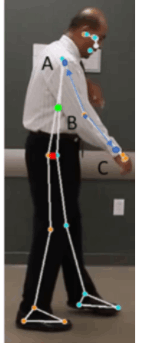
Challenge
With the rising prevalence of obesity and bad lifestyle choices, coupled with a sedentary lifestyle, most adults are likely to experience some physical discomfort. As the world adapts to the digitization of healthcare, there is a rising demand for a few patients to receive physical therapy remotely, with some receiving only remote physical therapy and others receiving both in-person and virtual care. During the COVID-19 pandemic in 2020, physiotherapy sessions declined by 84%. Many physiotherapists adopted remote physical therapy during the pandemic period. Remote physical therapy is a viable outpatient treatment option when dealing with major conditions. However, with the help of new technology, it is possible to fix this problem.
The scope of a physiotherapy company’s traditional practice appeared limited to them. They did get it to the point where they felt they couldn't do much more for their practice or their patients. As a result, the task was to develop a camera-based system for detecting patients. The precision of the project can be increased with the use of the SnipePlot project concept.
Solution
As a solution, we were able to design a camera based device to measure patients walking speed, measure patients angle between upper arm and lower arm (A), measure the stride length. This can help the physiotherapists to visit more patients every day, giving them the chance and time to innovate, explore new techniques, learn more, and personalize their care to each patient. Discover the success stories behind these case studies
So, in order to promote digital physical therapy, Senzmate collaborated with a digital physiotherapy company to build a camera-based device that the user or physiotherapist can fix to the tablet/phone and track the patient's motions.
Idea Stage
At the beginning stage, our team analyzed the overall approach on how to evaluate patients and what are the different approaches in video capturing.
Analyzing capacities of different mobile tabs, deciding the positioning of the mobile tabs, theoretical power consumption calculations, understanding the processing requirement, planning the data sets collection and preparation, analyzing practical feasibility in the implementation.
Prototype Stage
At the prototype stage, data collection for angle measurements only was taken. We worked on building a basic model with minimum data sets with angle measurements. Designed a basic API for uploading data points related to the cloud server. The team also designed a simple web dashboard to display the output of the patient movements to get an overview idea of physical health.
Variation of angle between lower and upper while a person is walking is calculated. This can be further expanded to other angles as well. Angle is continuously measured in each frame of the video. We were also able to visualize data and generate reports. We can spot developing trends and respond quickly based on what we see according to data visualization.
MVP Stage
We moved on to the minimum viable product stage, once the prototype testing yielded positive results. We were mainly focusing on large scale data collection. Building a basic model with all the following data sets;
The web interface has the following pages:
- Angle measurement
- Walking speed
- Stride length
The web dashboard and mobile app were also improved. The following tests were performed to ensure that the requirements were met in the actual world:
- A patient will be used for testing
- Test web dashboard, to ensure that it supports different browser and compatible with smartphone
Additionally, we developed the gait phase detection. With the model evaluation and results, the therapist should be able to guide the patient. Both the physical therapist and the patient should be able to compare the starting point to the current point, as well as the improvement over time.

Commercial Stage
With the feedback from the MVP stage, the system was fine tuned. We also finalized the bug free web dashboard and mobile app. Multiple points on the human body must be predicted in a video in order to do pose detection. We used Media pipe, a lightweight pose detection framework offered by Google, based on our previous expertise. It possesses the
- Lightweight model
- Mobile /Web versions available
- Cross-Platform capability (Windows, Mac, and Ubuntu)
- Faster detection
The installation manual, technical/developer manual, user operation manual documents were finalized and handovered to our Digital physiotherapy company clients.
Results
The stride and step lengths are measured in pixels, and the speed is calculated in pixels per second. These must be converted to distances in the real world. We tried a few different approaches and narrowed down our choices to a few.
- The use of meter tapes
- At a box, using two sticker reference points
We chose the sticker in a box option after weighing the pros and downsides of each method. Different methods were discussed with the team to improve the accuracy, such as the stickers should be visible, The camera angle should be horizontal to the ground and the camera should be stable, uploading a photo of the place with a reference object placed.
Written by Sinthuja